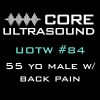52 y/o male presents with RUQ pain that radiates to his back. The pain was associated with vomitus and came on suddenly. This scan brought to you by Jacob Avila, MD, RDMS (@UltrasoundMD).

Diagnosis: Hydronephrosis due to an obstructing ureteral stone.
Although this patient had history suspicious for gallbladder disease, bedside ultrasound failed to find any abnormality in the gallbladder or common bile duct. This necessitated a further sonographic investigation. The patient did not have a history concerning for hepatic disease, so the kidney was evaluated, and moderate to severe hydronephrosis was uncovered.
This scan demonstrates moderate right sided hydronephrosis and a hyperechoic ureteral stone impacted at the UVJ, causing proximal hydroureter. The bladder was scanned in the transverse orientation and no right ureteral flow was observed when color power doppler was used, confirming the presence of an obstructing stone.
- The incidence of ureterolithiasis peaks between 20-50 years old and is less common as a new diagnosis passed the age of 501.
- Intraureteral stones themselves are very difficult to directly visualize, and instead an indirect sign of obstruction can be identified in the form of hydronephrosis2. However, occasionally the obstructing stone can be seen at the UVJ resulting in the visualization of hydroureter on the side of the hydronephrosis
- Hydronephrosis is diagnosed when hypoechoic (black) fluid is seen starting at the renal pelvis, and extending out into the medulla.
- The sensitivity and specificity of US for hydronephrosis when compared to CT scan has been reported in a systematic review to be 72-97% and 73-83%, respectively 2.
- Giving a 500 mL bolus of crystalloid prior to the scan may increase sensitivity for hydronephrosis3.
- While the ACR appropriateness criteria state that a CT scan in a patient with suspected first time ureterolithiasis is appropriate4, if a patient with a known history of ureterolithiasis presents with suspected renal colic, an US can be used to appropriately discharge the patient without the ionizing radiation of a CT scan5-6.
Scan and Post by: Jacob Avila, MD, RDMS
References
- Dalziel PJ, Noble VE. Bedside ultrasound and the assessment of renal colic: a review. Emerg Med J. 2013;30:3-8
- Noble VE, Brown DF. Renal Ultrasound. Emerg Med Clin N Am 2004;22:641-659
- Henderson S, Hoffner R, Aragona J, Groth D, Esekogwu V, Chan D. Bedside emergency department ultrasonography plus radiography of the kidneys, ureters and bladder vs intravenous pyelography in the evaluation of suspected ureteral colic. Acad Emerg Med 1998;5:666-71
- ACR appropriateness Criteria for acute onset flank pain. https://acsearch.acr.org/docs/69362/Narrative/ Accessed July 21,2014.
- Edmonds ML, Yan JW, Sedran RJ, McLeod SL, Theakston KD. The utility of renal ultrasonography in the diagnosis of renal colic in emergency department patients. CJEM. 2010;12:201-6
- Yan JW, McLeod SL, Edmonds ML, Sedran RJ, Theakston KD. Normal renal sonogram identifies renal colic patients at low risk for urologic intervention: a prospective cohort study. CJEM 2014;16:1-8




